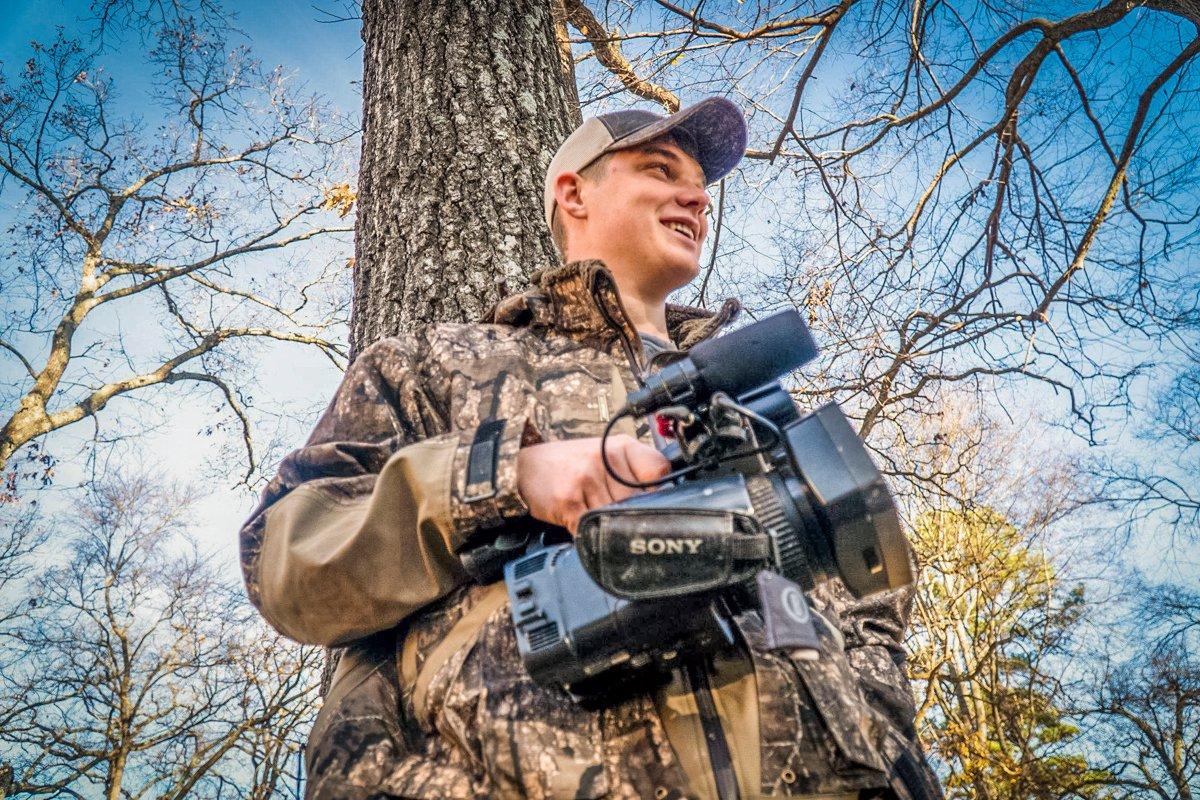A producer for Black Cloud on Realtree365 takes us behind the scenes of a waterfowling show
Watching the greenhead descend into a timber hole, air ripping through his primary feathers, you'd almost believe you're snugged against a tupelo tree, waiting to call the shot.
But you're not in the marsh. You're on your phone, sneaking a little of the boss's time in your office to watch a polished, professional duck hunting video. You're viewing the culmination of hundreds of days afield, countless hours of editing and a skill set built on trial and error.
Many hunters wonder how pro videographers capture such great footage. And many would love to apply that knowledge to their own filming efforts. They could learn from a guy like Cody McIntyre. He's a field producer for Black Cloud, the new public-land duck hunting program on Realtree365. Even though he's only 20 years old, he's already built a dazzling resume of waterfowl videography and has plenty of advice for folks who want to record their own memories afield.
Duck Roots
McIntyre started his career like many outdoor videographers: he's an avid hunter. He grew up in upstate New York and has chased waterfowl, deer and turkeys since he was 11. Despite having zero behind-camera experience, he took an internship after high school with Jon Lewis, a longtime producer of national waterfowl hunting shows.
He needed a camera guy and wanted to teach someone how to film and edit, McIntyre said. I'd never picked up a camera before then, and he taught me everything he knew. I was just really into waterfowl hunting. That was my main gig. He knew that, and I wanted to be able to continue to go as much as I wanted to, so I said I would do that internship.
A Pro's Gear
The main question many aspiring waterfowl videographers have is what kind of camera to purchase. McIntyre uses a Sony PXW-Z150 for his main camera and a Sony A6500 for a second camera and wide-angle option, along with a GoPro Hero 7
I recommend that Sony A6500 with an 18- to-105 power zoom lens for someone starting out because it's great for video," he said. "It can film in 120 fps (slow-motion) and 4K. It also takes great photos, so you get a multi-use camera for less than $1,500 new.
Tech Tips
McIntyre said the basic elements of good waterfowl videos are simple: capturing quality footage of birds along with the actions and reactions of hunters. But filming can be trickier than it sounds, and you'll have to sacrifice shooting birds to shoot footage instead.
I run everything in manual settings, McIntyre said. That way when you're in a blind, the auto-focus doesn't catch on the grass in front of the lens instead of the birds. And watch the lighting with the sky.
McIntyre's exposure settings vary depending on the conditions, especially when he's dealing with harsh dark and light conditions early in the morning. Sometimes, he runs the camera on automatic exposure settings, like when birds fly below the horizon in the predawn.
Sometimes, birds come in during early light, and the lighting isn't great, he said. Stuff happens really fast and you miss it, so you just have to be able to work around it and hold the camera on the hunter so you don't have shaky, bouncy footage. Turkeys come in slower, so you have a lot more time to make things right. With waterfowl hunts, it's now or never. Most of the time, you'll have a couple of more groups to make up for it if you miss an opportunity. But ducks move a lot faster than deer and turkeys.
One of the toughest aspects in filming waterfowl is spotting birds at a distance and focusing the camera on them as quickly as possible.
Just having a waterfowl background, I know what to look for and how birds act, McIntyre said. Find them with your eyes, and once you get them in the camera, don't look away from the camera. Just keep it as tight as you can on the bird, and follow through. Once you look up, you'll lose that bird. Find it in the viewfinder, and then don't take your eyes off the viewfinder.
McIntyre uses the peaking setting on his cameras, which highlights the edges of his subject in red or yellow in the viewfinder when the subject is in full focus. That helps him maintain focus on swiftly moving waterfowl. And he strives to record a variety of angles and exposures to give him more options when editing.
You don't want every shot as tight as possible or as wide as possible, he said. If you can get a little mix, that's ideal. Second angles are really important when it comes to editing so you can cut back and forth.
Building Blocks
As with most skills, experience is the only real way to learn to film a duck hunt. McIntyre said that experience only comes through experimentation and time afield.
Just do it, he said. Keep practicing. For somebody just getting into it, get hold of somebody already doing it, and talk to them if you really want to learn. YouTube is always a huge tool for learning about manual camera settings. But don't be afraid to mess up. Keep trying new stuff. You'll slowly get better.
McIntyre continues his education each season, filming 60-plus hunts per year, from the early September goose season in New York through the end of multiple duck seasons in late January. He's already filmed Black Cloud episodes this year in the Dakotas, Oklahoma and Arkansas, and will follow co-hosts Dennis Loosier and Billy Campbell to several other states. And although those early mornings and countless hours behind a camera or an editing suite might seem like a grind, McIntyre embraces the lifestyle and enjoys producing great video for fellow hunters to enjoy.
I have just as much fun watching and filming as I do shooting, he said.
Click here for more Realtree waterfowl hunting content. And check us out on Facebook.









